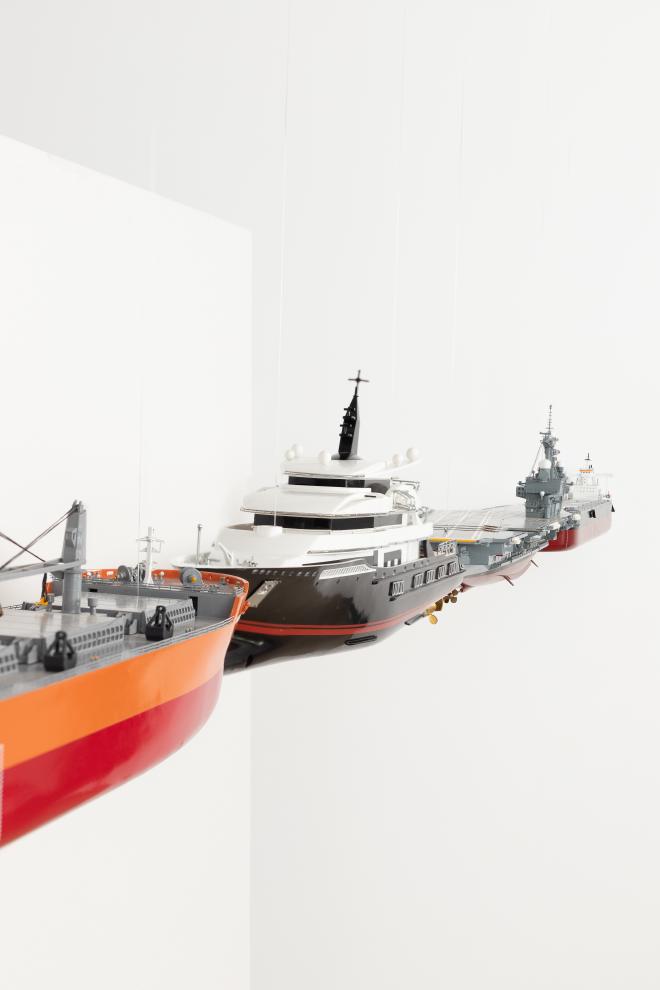- / News/
Sam Durant
Sam Durant L21 Gallery is pleased to announce Sam Durant’s first solo exhibition in Spain. Curated by Francesco Giaveri, the show presents an entirely new work developed for this occasion: Model for a Mediterranean Barricade. Obstructing the visitor’s way, it entangles a large-scale installation which divides the space of the gallery in two. Its departing point is a sci-fiction tale describing a dystopia that seems, however, very similar to our current reality. In this speculative scenario, European countries erect a wall to defend themselves against migrant ‘invasions’. There are many similar barricades, but in this case, it is built by boats. Floating in the sea side by side, they prevent from crossing. An even more radical solution than the naval blockade, this barricade of boats constitutes a physical barrier in the open sea. In the exhibition space, we find models of boats tied together, clearly identifiable by their different functions: military, transport of goods, recreational, etc. Following the story, their purpose becomes indifferent. All these ships lined up together serve only to create a bulwark; their only function is to establish an insurmountable frontier in the middle of the sea. They are no longer means to transport goods or people, to explore or simply to sail, but to prevent the arrival of the other. In this context, the use of the term ‘barricade’ is paradoxical since it takes us to urban scenes of popular revolts. It is easy to find examples of its use in a standard dictionary: “police broke through the barricades and arrested the protestors″. Or to think about May 68 when demonstrators lifted stones from the pavement to build barricades. The physical appropriation of urban space led to completely re-imagining both the city and life itself: ‘Sous les Paves, la Plage!’ The works of Sam Durant displace meaning seeking to expand the scope of a seemingly established imaginary once and for all. In particular contexts they might succeed in turning its very foundations upside down, thus opening a breach from which possibilities may emerge. They might even generate change. Although, when Bobby Gillespie wrote Imperial, a song inspired by the miners’ strikes of the 1980s, he had no illusions nor hopes about the ‘effects’ of protest songs. Still, he wrote it because they were lyrics that spoke about his life, where he came from and what was around him, and this was important: Just a matter of time
It goes around and around and around again
To converse
Into reverse
As always, while in opposite is found
A solid ground
A broken tree
A bended knee
Forever or until revolving knowing
Change winds are blowing
It goes around and around and around again. It is increasingly urgent to think in the reverse way. To imagine, without hope, other worlds. Any turn begins with a simple, but decisive, first displacement, as when Zack de la Rocha sang shouting “I won’t do what you tell me″. Quite a statement. In the language of hackers, these turns are called reverse engineering. An already classic text by Brian Holmes clearly explains the definition of reverse engineering hacker: “is simply the act of figuring out what software that you have no source code for does in a particular feature or function, to the degree that you can either modify this code, or reproduce it in another independent work″. The exhibition invites us to perform this same exercise by shifting meanings, modifying, as far as possible, the structures towards another purpose. The border formed by a series of boats in line formally refers to another functional structure for communal living, already known to the ancient people: the floating bridge. A system built by linking a series of boats of the same height to each other, floating gently on the water, successively joined with wooden panels to, contrary to the barrier shown here, allow the passage of people and goods from one side to the other. Sam Durant proposes many nods towards this direction of imagining and acting through the use of stratified materials (colours, objects, languages, research). His works contain many layers of meaning. A simple open your eyes (in fire red) is enough to activate that other look that invites us to imagine that another world is possible (in a serene sky blue). This last sign, an almost mythical slogan, is outside the exhibition space, where it can be seen in an unexpected way. It is there for everyone. Because, as Bobby Gillespie writes, “culture is one of the many insidious ways in which the plague of class elitism entrenches old power structures and stifles critical thinking″. These signs, light boxes that illuminate consciences, are phrases that have paraded in demonstrations. The artist reproduces through drawings the images that document the journey of these slogans. Both phrases Open your eyes and Another World is Possible, are totally imbued in the collective imagination. The first one is so powerful that beyond its primary meaning (i.e. as the equivalent of ‘wake up!’ or ‘notice what is happening around you’), it includes that primordial advice from parents to their children: ‘be careful’. The exhibition closes with Non-Vicious Circle, a tribute to surrealism with explicit echoes of Miró’s language. Sam Durant completes here his rotary movement by turning upside down the most aberrant functionality of the technique, turning bomb shells into sculptures, transforming something that falls from the sky to destroy into something that floats to delight. Useful and even urgent tools today: reverse imagining. What is important needs to be remembered, and the action of displacing, of moving oneself and to move something, contributes to awaken our attention and with it, our empathy. Imagining other worlds, even a utopia or, at least, a future for the Earth. Francesco Giaveri
curated by Francesco Giaveri
L21, Palma, Spain
15 September – 2 November, 2022
https://www.l21gallery.com/
